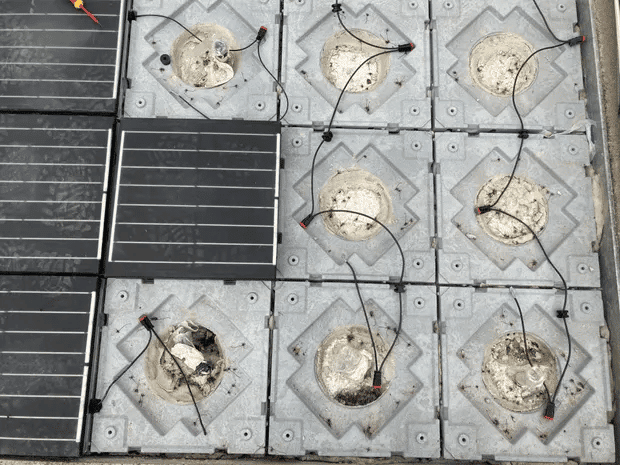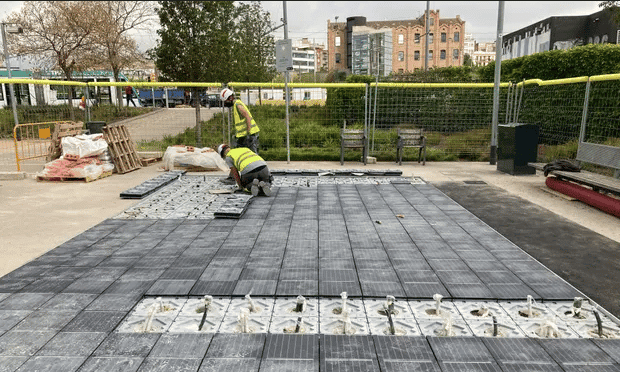Photovoltaic ground installation part of move to increase capacity close to where it’s most needed, in cities.
Barcelona city council has installed Spain’s first photovoltaic pavement as part of the city’s drive to become carbon neutral by 2050.
The 50 sq metres of non-slip solar panels, installed in a small park in the Glòries area of the city, will generate 7,560kWh a year, enough to supply three households.
The city has contributed €30,000 (£26,000) towards the cost, the remainder being met by the manufacturer, Platio Solar. The viability of the scheme will be assessed after six months. “We’ll have to assess the wear and tear because obviously it’s not the same as putting panels on a roof, although they are highly resistant,” says Eloi Badia, who is responsible for climate emergency and ecological transition at Barcelona city council.

“As for cost benefits, with a pilot scheme like this it’s difficult to know yet how much cheaper it would be if it were scaled up. We’re keen to install more on roofs and, if this scheme is successful, on the ground, to power lighting and other public facilities.”
However, he points out that Barcelona’s high population density means it would be difficult to generate enough electricity within the city limits to become self-sufficient.
“If we’re going to reach a target of zero emissions, we’re going to have to think about supplying electricity to blocks of flats, but we’ll also have to think of using wind and solar parks outside the city,” Badia says. “But installations on the ground like this open up new possibilities, and not just for Barcelona.”
The Barcelona scheme follows the installation of a 25-metre stretch of solar cycle lane in the Dutch city of Utrecht last year. The electricity generated is used to power lighting and also heat the path in winter to prevent it from icing over.
Most of Spain’s solar power comes from large farms in remote areas where land is cheap but which are a long way from centres of population. The move now is to increase capacity close to where it’s most needed, in cities.
“What we need to focus on is green policies to create employment, specifically to install solar panels on 1m rooftops,” says Fernando Prieto, executive director of the independent think tank Sustainability Observatory. “This would take five years, generate enough electricity for 7.5 million people, create over 15,000 jobs and cut CO2 emissions by 4.2m tonnes.”
He adds that it would lower the price of electricity and help citizens to become independent of the few power companies that dominate the industry.
“However, instead of this simple project, we are building installations of over 1,000 hectares on agricultural land and woodland, often with a negative impact on the environment,” Prieto says.
Under the previous conservative government solar installation came to an abrupt halt after punitive taxes were introduced. In 2018, the incoming socialist coalition scrapped the tax, triggering a boom in solar, with Spain now ranked 11th in the world for solar power and eighth for renewables overall.
Major retailers have got in on the act and now firms such as Ikea, electronics giant Media Markt and the department store El Corte Inglés are offering domestic solar installations at an average cost of €5,000 for a three-bedroom house.
Meanwhile, the government has announced plans to invest €1.5bn of EU Covid-recovery funds in the production of “green” hydrogen, using renewable energy to break up water molecules and release the hydrogen. Spain’s energy companies have said they will raise this to €8.3bn by 2030.
This article was amended on 30 April 2021. An earlier version referred to 7,560kW a year, when kWh was intended. It was further amended on 7 May 2021 to include the name of the manufacturer of the solar panels.


Recent Comments